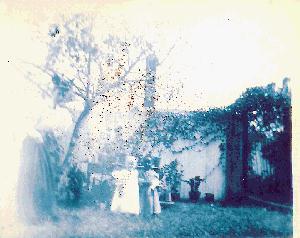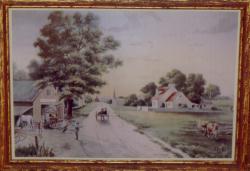|
 Two children and an adult pose for
an unknown photographer in the old fuzzy image at
left. It's bluish tint defines it as a
cyanotype, from an image-making technique popular
with amateur photographers in the middle of the
nineteenth century. This image, from the
Handley Library in Winchester, Virginia, was taken
on the Miller Plantation in Winchester in
1845. Although the adult is not identified,
the two children are: Katie Miller is on the
left, and Mary Johnson is on the right. Katie
Miller is a daughter of the wealthy Miller family,
who have just received a gift in the form of
five-year-old slave Mary Johnson, as a Christmas
present--possibly the occasion for this picture.1 Two children and an adult pose for
an unknown photographer in the old fuzzy image at
left. It's bluish tint defines it as a
cyanotype, from an image-making technique popular
with amateur photographers in the middle of the
nineteenth century. This image, from the
Handley Library in Winchester, Virginia, was taken
on the Miller Plantation in Winchester in
1845. Although the adult is not identified,
the two children are: Katie Miller is on the
left, and Mary Johnson is on the right. Katie
Miller is a daughter of the wealthy Miller family,
who have just received a gift in the form of
five-year-old slave Mary Johnson, as a Christmas
present--possibly the occasion for this picture.1
Mary E.
Johnson was born in Clarke County, Virginia on or
about November 12, 1839. After the tumult of
the Civil War she married widower Thomas W. Moss, a
veteran of the 35th USCT, a Union regiment organized
in the summer of 1863 as the First North Carolina
Colored Volunteers. The unit was mostly
composed of men who had been slaves in North
Carolina and Virginia.2
The
Moss family lived in Winchester, and on March 7,
1878, she gave birth to their second child, Charles
Franklin. The young man must have shown
an aptitude for art, because he held apprenticeships
in Providence and Newport, Rhode Island, according
to the Cumberland County 2000 Arts and Cultural
Directory. "After this he studied at the
Cooper Union School of Fine Arts, NYC and the
Philadelphia Academy of Fine Arts,"3
where, according to family lore, he met and studied
with fellow student Henry Ossawa Tanner.
Locally,
Charles Franklin Moss came to Harrisburg, probably
sometime after 1907. He brought his growing
family, consisting of his wife Sarah Virginia
Townson, whom he married in Winchester about 1898,
and five children, to Central Pennsylvania, settling
first in the capital city. Having an interest in
photography, he opened a studio on Market Street in
the city, where he practiced his trade for a short
while. A daughter, Ruth Moss-Green, states
that a number of white photographers in Harrisburg
learned the trade from Moss. It is not known
how long Charles F. Moss kept his business in
Harrisburg, but at some point he moved his family to
Carlisle, in Cumberland County.4, 5
 Moss continued to practice his
photography trade in Carlisle, eventually
establishing a studio on North Pitt Street. In
1914 he became the first African American member of
the National Association of Professional
Photographers. A surviving photograph that
Moss took of the Shiloh Baptist Sabbath School in
Carlisle is dated 1919, showing that Moss kept his
business in that place at least through that
year. His youngest child, Helena, was born in
1920 in Carlisle. Of twelve children born to
Charles and Sarah Moss, seven would be born in
Cumberland County, Pennsylvania, between the years
1911 and 1920.6 Moss continued to practice his
photography trade in Carlisle, eventually
establishing a studio on North Pitt Street. In
1914 he became the first African American member of
the National Association of Professional
Photographers. A surviving photograph that
Moss took of the Shiloh Baptist Sabbath School in
Carlisle is dated 1919, showing that Moss kept his
business in that place at least through that
year. His youngest child, Helena, was born in
1920 in Carlisle. Of twelve children born to
Charles and Sarah Moss, seven would be born in
Cumberland County, Pennsylvania, between the years
1911 and 1920.6
Carlisle
historian Ruth Hodge, who is actively researching
Charles Franklin Moss, Sr., notes that Moss moved to
Pittsburgh sometime in the 1920's. He
eventually returned to his roots in Winchester,
where he died in 1961.7
The
painting shown at right, above, is owned by
descendants of Charles F. Moss, Sr., and was
photographed by Sheila Green-Stevenson for this
article. It is signed at the bottom edge,
where the road meets the edge of the
canvas: "Chas. F. Moss, Sr./ 1933."
Click the thumbnail image for a larger image.
Sources:
- Correspondence, Sheila
Green-Stevenson to Afrolumens, October 13, 17,
19, 2003.
- "First North Carolina
Colored Infantry," Internet site, accessed
December 12, 2003.
http://extlab1.entnem.ufl.edu/olustee/35th_USCI.html;
"Our Virginia, D.C., Pennsylvania, New Jersey
Genealogies," Internet site, accessed December
14, 2003. http://worldconnect.genealogy.rootsweb.com/cgi-bin/igm.cgi?op=GET&db=fox2&id=I31955.
- 250 Years of the Arts:
Arts and Cultural Directory for Cumberland
County, 2000, Cumberland County,
Pennsylvania 250th Anniversary
publication. Carlisle, Pennsylvania, pages
9-10. A photograph of Charles Franklin
Moss, Sr. as a young man is included on page 9
of this publication.
- "Our Virginia, D.C.,
Pennsylvania, New Jersey Genealogies"
- The statement by Ruth
Moss-Green is from an interview conducted by
Sheila Green-Stevenson recently, and is
contained in a letter from Sheila
Green-Stevenson to Afrolumens Project, September
25, 2003.
- 250 Years of the Arts:
Arts and Cultural Directory for Cumberland
County, p. 10; "Woman tells lensman's
story," Elizabeth Gibson, Carlisle
Patriot-News edition of the Harrisburg Sunday
Patriot-News, December 2, 2001, p. AA1,
AA3. This newspaper article includes the
photograph of the Shiloh Baptist Sabbath School,
taken by Moss in 1919.
- "Woman tells lensman's
story;" "Our Virginia, D.C., Pennsylvania, New
Jersey Genealogies."
|
